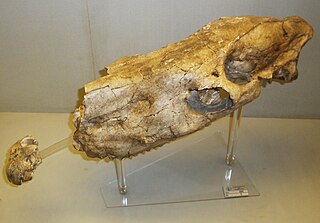
The Neogene is a geologic period and system that spans 20.45 million years from the end of the Paleogene Period 23.03 million years ago (Mya) to the beginning of the present Quaternary Period 2.58 million years ago. The Neogene is sub-divided into two epochs, the earlier Miocene and the later Pliocene. Some geologists assert that the Neogene cannot be clearly delineated from the modern geological period, the Quaternary. The term "Neogene" was coined in 1853 by the Austrian palaeontologist Moritz Hörnes (1815–1868). The earlier term Tertiary Period was used to define the span of time now covered by Paleogene and Neogene and, despite no longer being recognized as a formal stratigraphic term, "Tertiary" still sometimes remains in informal use.

Ostriches are large flightless birds. Two living species are recognised, the common ostrich, native to large areas of sub-Saharan Africa, and the Somali ostrich, native to the Horn of Africa.

Cetotherium is an extinct genus of baleen whales from the family Cetotheriidae.

Agriotherium is an extinct genus of bears whose fossils are found in Miocene through Pleistocene-aged strata of North America, Eurasia, and Africa. This long-lived genus persisted from at least ~11.6–2.5 Mya. Materials from the late-surviving A. africanum in Africa have suggested that A. africanum died out during the early Gelasian.

Cycloderma is a genus of softshell turtles in the subfamily Cyclanorbinae of the family Trionychidae. The genus is endemic to Africa.

Chelonoidis is a genus of turtles in the tortoise family erected by Leopold Fitzinger in 1835. They are found in South America and the Galápagos Islands, and formerly had a wide distribution in the West Indies.

Eurygnathohippus is an extinct genus of hipparionine horse. The majority of known fossils of members of this genus were discovered in Africa, where members of this genus lived during the late Miocene to Pleistocene interval. Fossils of Eurygnathohippus were also reported from the late Pliocene sediments of the Potwar Plateau in Pakistan and the Siwalik Hills in northwest India.

The Pisco Formation is a geologic formation located in Peru, on the southern coastal desert of Ica and Arequipa. The approximately 640 metres (2,100 ft) thick formation was deposited in the Pisco Basin, spanning an age from the Middle Miocene up to the Early Pleistocene, roughly from 15 to 2 Ma. The tuffaceous sandstones, diatomaceous siltstones, conglomerates and dolomites were deposited in a lagoonal to near-shore environment, in bays similar to other Pacific South American formations as the Bahía Inglesa and Coquimbo Formations of Chile.
Hypsitherium is an extinct genus of Mesotheriidae that lived 4.0 to 3 million years ago. It is known from the Miocene to Pliocene Inchasi fossil locality in Bolivia. Hypsitherium was a scansorial herbivore, and its name translates to "high beast."

Hippohyini was an extinct tribe of Suinae which existed in Asia during the Pliocene.
Sinohyus was a genus of ground dwelling omnivorous even toed ungulates that existed in Asia during the Pliocene.
Sivahyus was a genus of ground dwelling omnivorous even toed ungulates that existed in Asia during the Pliocene.
Albanohyus was an extinct genus of even-toed ungulates which lived during the Miocene in Eurasia and possibly Africa.
Cainochoerus was an extinct genus of even-toed ungulates which lived during the Miocene and Pliocene in Africa. Fossils have been found in Kenya, Ethiopia and South Africa.

Hyotheriinae was a subfamily of even-toed ungulates that existed during the Miocene and Pliocene in Europe, Asia, and Africa.

Aureliachoerus was an extinct genus of suids that existed during the Miocene in Europe.
Nguruwe was an extinct genus of even-toed ungulates that existed during the Miocene in Africa. It was formerly considered a member of the subfamily Listriodontinae, but has since been placed in Hyotheriinae.
Xenohyus was an extinct genus of suids that existed during the Miocene in Europe.
Parachleuastochoerus was an extinct genus of even-toed ungulates that existed during the Miocene in Europe. It was a smaller descendant of the Conohyus genus, with narrower cheek teeth and reduced premolars.
Potamochoeroides was an extinct genus of even-toed ungulates that existed during the Pliocene in South Africa.











